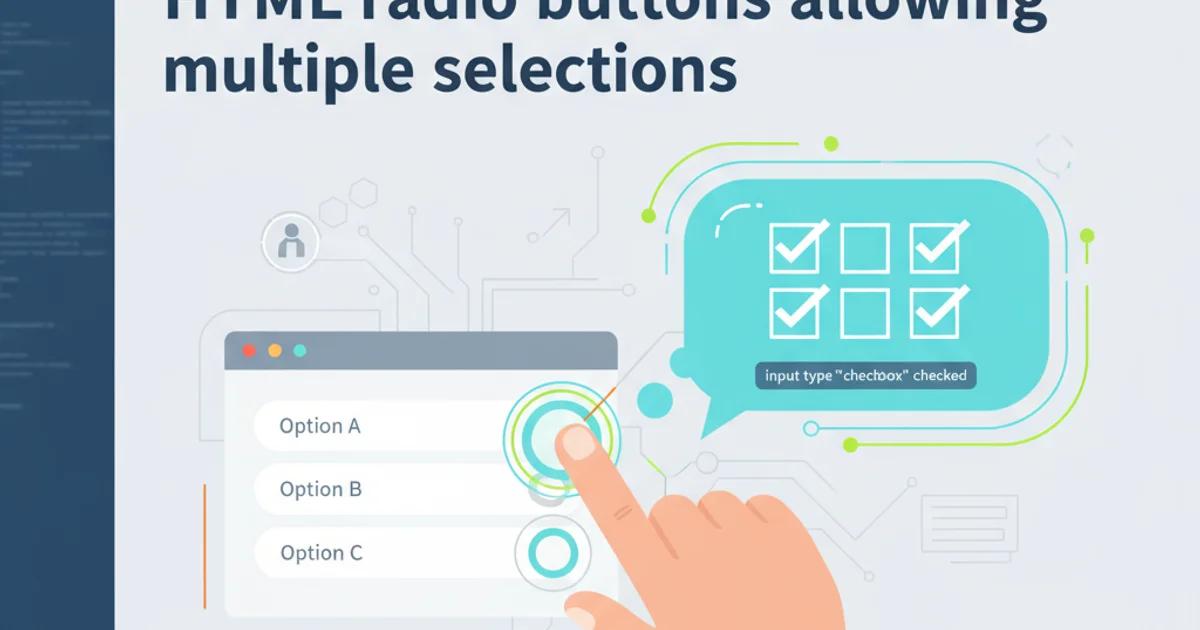HTML radio buttons allowing multiple selections
Categories:
HTML Radio Buttons: Understanding Single vs. Multiple Selection

Explore the fundamental behavior of HTML radio buttons, why they enforce single selection, and how to achieve multiple-choice functionality using alternative form elements.
HTML radio buttons are a common form element used to allow users to select a single option from a predefined set. Their design inherently enforces mutual exclusivity, meaning only one radio button within a given name group can be selected at any time. This behavior is crucial for scenarios where only one choice is valid, such as selecting a gender, a payment method, or a difficulty level.
The Nature of Radio Buttons: Single Selection
The core purpose of an HTML radio button is to provide a set of mutually exclusive options. When you define multiple <input type="radio"> elements with the same name attribute, the browser automatically handles the single-selection logic. Selecting one radio button in the group deselects any previously chosen button within that same group. This design ensures data integrity for questions requiring a unique answer.
<form>
<p>Choose your favorite color:</p>
<input type="radio" id="red" name="fav_color" value="red">
<label for="red">Red</label><br>
<input type="radio" id="blue" name="fav_color" value="blue">
<label for="blue">Blue</label><br>
<input type="radio" id="green" name="fav_color" value="green">
<label for="green">Green</label>
</form>
Example of standard HTML radio buttons enforcing single selection.
name attribute is critical for grouping radio buttons. Without a shared name, each radio button would behave independently, allowing multiple selections, which defeats their intended purpose.Achieving Multiple Selections: Checkboxes to the Rescue
If your goal is to allow users to select multiple options from a list, radio buttons are not the correct HTML element. Instead, you should use checkboxes (<input type="checkbox">). Checkboxes are designed for independent selection, meaning a user can select zero, one, or many options from a group without affecting the selection state of others.
<form>
<p>Select all toppings you want:</p>
<input type="checkbox" id="pepperoni" name="toppings" value="pepperoni">
<label for="pepperoni">Pepperoni</label><br>
<input type="checkbox" id="mushrooms" name="toppings" value="mushrooms">
<label for="mushrooms">Mushrooms</label><br>
<input type="checkbox" id="olives" name="toppings" value="olives">
<label for="olives">Olives</label>
</form>
Using checkboxes to allow multiple selections for toppings.
flowchart TD
A[User needs to select options?] --> B{Single or Multiple?}
B -->|Single| C[Use Radio Buttons]
B -->|Multiple| D[Use Checkboxes]
C --> E[Group with same 'name' attribute]
D --> F[Each checkbox independent]Decision flow for choosing between radio buttons and checkboxes.
name attribute (e.g., name="toppings[]" in PHP, or simply name="toppings" in many modern frameworks that automatically parse arrays).Why Not Force Radio Buttons for Multiple Selection?
Attempting to hack radio buttons to allow multiple selections (e.g., by using JavaScript to override their default behavior) is strongly discouraged. It violates the expected user interface patterns, leading to confusion and a poor user experience. Users are accustomed to radio buttons meaning 'choose one' and checkboxes meaning 'choose many'. Deviating from these established conventions makes your forms less intuitive and harder to use.